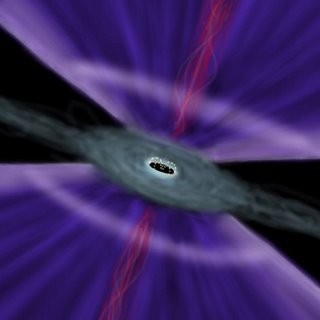New View of Quasars

_____________________________________________
Artist illustration of a Quasar. - Image credit: CfA Enlarge Image
Some of the brightest objects in the Universe are Quasars.
A mystery for decades, most astronomers now believe Quasars are the bright centres of galaxies with actively feeding supermassive black holes. A team of researchers have found evidence that there might be something very different at the heart of these galaxies to cause quasars. Instead of black holes consuming matter, there could be objects with powerful magnetic fields that act like propellers, churning matter back into the galaxy.
In the distant, young universe, quasars shine with a brilliance unmatched by anything in the local cosmos. Although they appear starlike in optical telescopes, quasars are actually the bright centers of galaxies located billions of light-years from Earth.
The seething core of a quasar currently is pictured as containing a disk of hot gas spiraling into a supermassive black hole. Some of that gas is forcefully ejected outward in two opposing jets at nearly the speed of light. Theorists struggle to understand the physics of the accretion disk and jets, while observers struggle to peer into the quasar’s heart. The central “engine” powering the jets is difficult to study telescopically because the region is so compact and Earth observers are so far away.
Astronomer Rudy Schild of the Harvard-Smithsonian Center for Astrophysics (CfA) and his colleagues studied the quasar known as Q0957+561, located about 9 billion light-years from Earth in the direction of the constellation Ursa Major, near the Big Dipper. This quasar holds a central compact object containing as much mass as 3-4 billion Suns. Most would consider that object to be a “black hole,” but Schild’s research suggests otherwise.
“We don’t call this object a black hole because we have found evidence that it contains an internally anchored magnetic field that penetrates right through the surface of the collapsed central object, and that interacts with the quasar environment,” commented Schild.
Schild and his colleagues found that the jets appear to emerge from two regions 1,000 astronomical units in size (about 25 times larger than Pluto-Sun distance) located 8,000 astronomical units directly above the poles of the central compact object. (An astronomical unit is defined as the average distance from the Earth to the Sun, or 93 million miles.) However, that location would be expected only if the jets were powered by reconnecting magnetic field lines that were anchored to the rotating supermassive compact object within the quasar. By interacting with a surrounding accretion disk, such spinning magnetic field lines spool up, winding tighter and tighter until they explosively unite, reconnect and break, releasing huge amounts of energy that power the jets.
“This quasar appears to be dynamically dominated by a magnetic field internally anchored to its central, rotating supermassive compact object,” stated Schild.
Further evidence for the importance of the quasar’s internally anchored magnetic field is found in surrounding structures. For example, the inner region closest to the quasar appears to have been swept clean of material. The inner edge of the accretion disk, located about 2,000 astronomical units from the central compact object, is heated to incandescence and glows brightly. Both effects are the physical signatures of a swirling, internal magnetic field being pulled around by the rotation of the central compact object - a phenomenon dubbed the “magnetic propeller effect.”
This research suggests that, in addition to its mass and spin, the quasar’s central compact object may have physical properties more like a highly redshifted, spinning magnetic dipole than like a black hole. For that reason, most approaching matter does not disappear forever, but instead feels the motor-like rotating magnetic fields and gets spun back out. According to this theory, a MECO does not have an event horizon, so any matter that is able to get by the magnetic propeller is gradually slowed down and stopped at the MECO’s highly redshifted surface, with just a weak signal connecting the radiation from that matter to a distant observer.
This research was published in the July 2006 issue of the Astronomical Journal, and is available online at http://arxiv.org/abs/astro-ph/0505518.
A new view on Quasars Universe Today
Original Source: CfA News Release
Carbon atoms in graphite form honeycomb structure, read on:
Pencils Blackholes and the Klein Paradox by Stefan @ Backreaction
_______________________________________________________
_______________________________________________________
Famous Quotes
The shortest way to do many things is to do only one thing at once.
Samuel Smiles
_______________________________________________________


<< Home